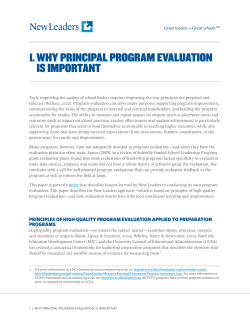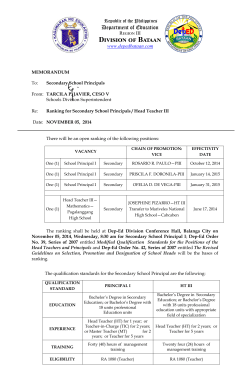
Considering Principal Evaluation as Means of Renewal, Reflection
Advancing Women in Leadership Vol. 35, pp. 76- 81, 2015 Available online at http://advancingwomen.com/awl/awl_wordpress/ ISSN 1093-7099 Full Length Research Paper Considering Principal Evaluation as Means of Renewal, Reflection and Growth Brenda L. Harper Brenda Harper: Kent State University, Kent, Email bharper5@kent.edu Accepted February 24, 2014 In this article, the author examines the current context of educational leadership evaluations and how this context might be reimagined and operationalized in terms of feminist ideas and ideals in which collaboration, renewal, development and growth are valued throughout the evaluative process. Feminist philosophy is explored and applied to the feedback process for educational leaders, enabling them to sustain and renew in a climate of intense scrutiny and accountability. Keywords: feminist, feminism, leadership, accountability Introduction The history of education has been guided by men (Greene, 1993). Although women fill the teaching ranks, they have historically not set the rules and outlined the precedents of educational landscape. Early patriarchal norms established the character and lived situation of properly employable females (unmarried, humble and gentle) suitable to guide America’s children and have subsequently defined the current structure and common goals of education including ideas of producing zero defect products and the ultimate aspiration for students being capacity for economic prosperity (Greene, 1985; Greene, 1993). It is not surprising then that a male normative process of evaluation exists and that women in leadership continue to function within the conditions of a hegemonic framework in this regard (Wilson & Nutley, 2003). Maxine Greene (1993) talks about early school reform writers such as Horace Mann who delineated ideas of what successful education should look like. His ideas promoted the equalized conditions of humanity with the supposed neutral persona including all persons although women were not truly part of this opportunity. Similarly, there is still a tightly held articulation of what a successful educator looks like and how he/she is evaluated in a standardized accountability culture. Women work on the fringes to guide this articulation, pushing and nudging the framework already in play. Qualities typically associated with male leadership such as control and competition are presently idealized as the best management qualities (Reay & Ball, 2000). In fact, Marshall (1984) states, “…leadership characteristics and the masculine sex role correspond so closely that they are simply different labels for the same concept” (p. 19). Current educator evaluation practices are focused heavily on accountability, representing a Advancing Women in Leadership 2015 Volume 35 broader accountability movement whose practices are highly associated with control and competition. In today’s accountability climate for education, policy makers, not just educators, are playing a larger role in establishing evaluation criteria (Babo & Villaverde, 2013; Piro, Wiemers, & Shutt, 2011). In this climate, schools are pressured to demonstrate success through narrowed definitions and markers of progress reliant to a significant degree upon once a year normed tests (Keith, 2011; Piro, et al, 2011 ;). Accountability is the buzzword in an environment where districts, schools and individual professionals are measured and assigned rankings corresponding to performance or failure to perform in accordance with prescribed criterion of accountability. Student achievement measures, i.e. student standardized test scores, are appearing more often in district and state-wide personnel evaluation systems for educators. Such annual personnel evaluations cannot constitute the only means of feedback that teachers and leaders receive regarding the efficacy of their practice (Parylo, Zepeda, & Bengston, 2012; Siens & Ebmeier, 1996). This annual high stakes feedback contributes to the competitive rankings driven milieu as opposed to one focused on the growth of every leader and educator within his/her lived context serving concrete and individualized students with specific needs which vary from school district to school district, situation to situation. Greene’s (1984) concept of educator success is articulated by the following, If we are ‘successful’ or ‘effective,’ then, there will be no visible product for which we can take the credit. There will be diverse individuals in diverse contexts, engaging in continually new beginnings as they work to make sense of their worlds. (p. 62). 76 Those who align with this concept may be perceived as antiintellectual, fuzzy headed or operating under a naiveté that is not data-driven, another buzzword in the accountability culture vernacular. Despite the potential of being labeled as one or all of the aforementioned pejoratives, I am challenged by Greene (2000) who calls us to imagine educational ideals and practices differently than they currently exist when she states, “There are many instances of images of the possible calling attention to what is lacking that break through the boundaries laid down by the taken-for-granted” (p. 273). In the case of principal evaluation this means breaking the boundaries of the taken for granted by re-imagining the process as iterative, renewing and egalitarian as opposed to singular and summative. Demands on School Leaders Research studies consistently demonstrate that meaningful professional development and support systems are lacking to assist leaders in directly impacting student achievementespecially in terms of assisting minority students, students with disabilities and economically disadvantaged students that must show rigorous yearly growth in order for principals to achieve successful evaluations (Daresh, 2007; Honig 2012; Keith, 2011). Although there is a sound base of information available on the mentoring and induction of new principals to the profession in the literature, there is considerably less information on best practices to support established principals underlining the lack of a well-articulated support structure for those responsible for leading our nation’s schools. Honig (2012) highlights this stating, “Previous work in educational leadership has barely explored job-embedded professional supports for school principals’ learning, let alone how executive level central office staff might participate as main agents in that work” (p. 764). Established principals continue to need reinforcement and renewal. If not provided, principals can lose focus and fail to self-reflect, limiting their ability to continually improve practices, move their schools forward and maintain perceptions of efficacy. An important component that may be easily overlooked regarding support and professional development is that of the emotional and social competencies required in the principal role. Cooley and Shen (2000) found there is a significant emotional impact on principals related to stress, second guessing from multiple publics, bureaucratic requirements and frustrations that may result in burnout. Williams (2008) ascertained that the social and emotional skills of selfconfidence, achievement orientation, initiative, organizational awareness, leadership and collaboration were all significantly related to sustained excellence in the principal role. Lack of support for administrators ranks among the ten most important factors influencing principals’ desire to remain in or leave the profession (Cooley & Shen, 2003). It is vital that those responsible for supporting principals understand and address this. Altering the processes and context in which leadership evaluations are structured and delivered provide a Advancing Women in Leadership 2015 Volume 35 dynamic means of supporting principals to sustain growth, renewal, and perceived efficacy. The modern educational leader faces multiple publics, priorities and tasks during the day-to-day work of the job. As stressors associated with educational leadership positions rise, a number of potential candidates are declining application to the profession and those currently employed are turning over at a less than desirable rate (Cooley & Shen, 2000). Marzano, Waters and McNulty (2005) outlined a diverse range of educational leadership competencies necessary for success including cultural capacity, understanding of curriculum, facility with assessment and instruction, relationship building and the ability to make changes. Conflict with teacher unions, school boards, parents, and increased administrative duties are all factors associated with decreased interest in the principal position (Cooley & Shen, 2000). Urban principals in particular are faced with additional challenges such as student mobility, teacher retention and school violence. Increased responsibilities afford less time for cultivating relationships with stakeholders and in engaging in their own professional development. Time pressures often negatively impact a principal’s interactions with her family and school leaders often find they are toiling beyond normal working hours (Portin, 2000). Additionally, principals are now key players in providing professional development to teachers in interpreting growth and accountability measures. Under these conditions, fatigue and self-doubt contribute to decisions of leaders to drop out of the profession or experience reduced self-efficacy. (Kneese, Pankake, Schroth, & Blackburn, 2003; Portin, 2000). Professional development and renewal techniques are critical in a profession that taps such diverse competencies and demands a multiplicity of results. However, those in the field report that support and renewal structures and meaningful professional development allowing them to grow and become more effective are inadequate (Cooley & Shen, 2003; Marcos, Witmer, Foland, & Vouga, 2011). To ameliorate this, a re-thinking is necessary in terms of educational leadership personnel evaluation. A serious consideration of evaluative practices that align with norms other than those currently established in accountability based paradigms are warranted. Such a realignment will afford a much needed avenue for growth and renewal. It is commonly noted that there is a constant tension in the evaluation process that exists between development and accountability, between formative and summative assessment (Shoaf, Zigler, & Beebe, 2013). In the state of Ohio, along with a large number of the states in the nation, there is a strong focus on school administrator accountability by including student growth measures in evaluation. Goal setting, based on narrowly defined data points and evidence gathering to prove mastery is commonplace (Piro, et al., 2011). I question the ability of these evaluative frameworks to promote deep selfreflection and the capacity to assist administrators in learning journeys that allow them to explore and take risks within a safe and collaborative environment. 77 Support for School Leaders Considering school leadership evaluation as a multi-year roadmap for professional development, long term growth, discourse and reflection will not only provide a means of renewal and growth but also will calibrate more closely with dialogical and power equalizing methods espoused by feminist thought and ideals. These ideals situate growth, development and problem solving within contextualized situations involving what Seyla Benhabib (2008) references as “embedded and embodied” realities. The traditional banking model of learning and the adversarial self-doubting model, which I equate most closely with the evidence gathering mechanics of today’s evaluations, are not aligned with feminist thought which is more carefully connected with a problem posing model in which questioning and dialogue are encouraged between participants. Additionally, feminist theorists favor connected knowing as opposed to proving knowledge and value efforts to learn as opposed to efforts to please (Belenky, Clinchy, Goldberger, & Tarule, 1986). Noddings (1984) addresses this in a seminal work when she advocates engagement in questionraising instead of rule following. Current standards and rubrics contained in principal evaluation models do not lend themselves to the dialogue that starts with, “what if?” but rather relegates leaders to proving their completion of prescribed competencies. In Bitter Milk, Madeline Grumet (1988) talks about a patriarchal standard of education which views curriculum and teaching (and therefore associated evaluations) as a means to an end in the form of products including test scores and various forms of accountability. She goes on to say that curriculum, under this male dominated ideology, is formed around the abstract unnamed student as opposed to being a dynamic and changing construct based on real students in context who respond to and question the content (more in line with feminist thinking). Specifically, Grumet (1988) articulates this by stating, “The rules fit the curriculum but the curriculum does not fit anybody” (p. 165). These ideas dovetail with those of Nodding (1984) who talks about the decrease of caring when persons are relegated to the status of being a “case.” I immediately think of accountability measures and standardized scores. In the realm of principal evaluation, I think of student growth measures by which student scores translate to principal ratings. This context makes it all too easy for students to be seen as “cases” as opposed to individuals with needs and aspirations in which the principal plays a large part through curriculum and instructional leadership and the establishment of school culture which directly impacts a student’s well-being on a daily basis. For example, will a principal with third grade reading scores well below average approach reflection about classroom climate and its effect on learning or automatically move to disaggregating data according to skill set? Will a principal working with a teacher through a newly designed evaluation system think to coach a teacher about making connections and relationships with students as the key to improving their achievement or will the focus be narrowly Advancing Women in Leadership 2015 Volume 35 confined to technical competencies and instructional delivery methods aimed at moving the teacher to the next rung on the state designations ladder? Noddings (1984) develops the idea of seeing another person as data point and then moving back to the personal. It is of utmost importance that principals and those holding them accountable (evaluating them) never lose sight of this necessity of returning to the personal because in the end students are persons we serve, persons we have a profound influence upon. Students are not simply products to be developed at a zero defect rate to increase the efficiency of economic development, but rather persons that will contribute to relationships of caring and personal fulfillment throughout their lifetime. Greene (1993) presents the idea of individual consideration artfully asserting that educators require, The sense of presentness and responsibility that accompanies the realization of constructing knowledge from situated vantage points in the world. There has to be pondering, wondering, thinking in terms of networks and textures, thinking resembling Whitney Otto’s ‘quiltmaking,’ with its multiple patterns, its randomized realities” (p. 253). I find Noddings (1984) understanding of the grading of students interesting in terms of care theory and directly applicable to the “grading” contained in the personnel evaluations of today. She postulates that the caring relation is broken between students and teacher when grades are assigned because grades are for others whereas feedback is for the student-to encourage reflection and growth. Once the teacher publishes a grade, the caring relationship is disrupted. She suggests an external summative grader be considered. If this same thinking is applied to principal evaluation, the focus would be on a developmental relationship in which reflection and learning is of utmost priority in which pairs of professionals dialogue, learn and grow together with an emphasis on reflection without a summative or grading component to disrupt the relationship. This relationship would be equal, collaborative and enduring (i.e. not a one year mentoring program for new principals to learn the ropes or an annual yearly ranking supported by isolated achievement data points from the year prior). James-Ward and Potter (2011) qualitatively describe a collaborative school administrator coaching process that has the effect of developing “reflective, courageous leaders” (p. 126) through dialogue and feedback. The coaching program was built on inquiry processes and personal discovery to define goals with targeted feedback in a trusting non-threatening environment. To face the complex challenges that principals are faced with today, policy makers should seriously consider the propensity to grow courage and reflection, not only proficiency and attainment of performance targets. Perhaps Noddings (1984) ideas of care theory should be applied to principal evaluation in which elements of reflection and accountability might co-exist with decreased tension by divorcing the coaching and dialogue relationship from the summative evaluation component. Multi-year cycles of summative evaluation would allow this to be accomplished 78 as would a framework more heavily valued for growth as opposed to accountability. In their work on the self-efficacy of women leaders, Momsen and Carlson (2013) talk about learning as a social process in which people learn from observing and simulating others, citing the work of cognitive social psychologist Albert Bandura. They contend that as women in leadership interact with others through observation and engage in encouraging dialogue and confidence building activities, they build selfefficacy which in turn promotes higher job performance. I am left questioning whether “real talk” as referenced by Belenky et al. (1986) in their pioneer work articulating women’s understandings is a part of current evaluation conversations. This “real talk” is that in which, “…domination is absent and reciprocity and cooperation are prominent” (p. 146). Skepticism regarding real talk arises from the fact that all evaluation terms and language are scripted and defined along a continuum of performance provided to educational leaders to internalize as well as be placed somewhere on that continuum. Many accountability based performance evaluations are closed as opposed to open ended, discouraging rather than encouraging dialogue. Statements replace questioning throughout the process. Portfolio Considerations Portfolio use in evaluations provides another potential vehicle to assess principals that can work within a competency based framework and also provide the means for reflection, feedback, growth and renewal. Important to understand is the fact that not all portfolio practices are the same with regards to their intent, process and outcome. Dossier portfolios articulate the types of performance artifacts that should be collected, being somewhat of the checklist version of portfolios. A course or program linked learning portfolio involves defining objectives and the collection of artifacts to demonstrate competence levels (Babo & Villaverde, 2013). A third, more powerful portfolio approach is the reflective learning portfolio which has a focus on learner generated items which demonstrate growth in competence areas (Tillema, 2011). Regarding portfolios, Tillema (2001) asserts that too strong a pre-occupation on performance evaluation can be counter-productive to growth and development. While gathering pieces for the portfolio, “An emphasis should be placed on reflection, insights gained, reasoning and deliberation, with the appraisal piece arising naturally through the collection of evidence, and reflection on its relevance and meaning” (p. 95). Portfolios can be especially valuable in a peer review process, a method which could be used to promote critical reflection (Williams, 2009b). It is important portfolios be used in an atmosphere of trust and unity with participants being able to set goals and self-reflect along the way, using the portfolio to reflect thinking in progress (Babo & Villaverde, 2013). The process of compiling a portfolio requires principals to be active self-directed learners as they invest physical and mental energy into meaningful learning (Mestry & Schmidt, 2010; Williams, 2009b). An Advancing Women in Leadership 2015 Volume 35 important caution is that the compilation processes not fall into the trap of being contrived as opposed to authentic. This may happen when principals feel pressured to prove they have accomplished a number of competencies at a desired level. When the priority is on growth and development there is less pressure to show that one “has arrived.” Hargreaves, Earl, and Schmidt (2002) caution regarding portfolio assessments that, “…simulate rather than stimulate achievement” (p. 90). In addition to encouraging reflective engagement in assessment, portfolios have the potential to disrupt traditional power relations that may favor certain populations (Mestry & Schmidt, 2010). Women, in particular, may benefit from gathering specific contribution pieces that represent a whole or holistic picture of their leadership growth and development with strong contextual reference and connection. Traditional male understanding is focused on generalizing whereas women-related understandings are more particular and specific to immediate context with local events and contingencies affecting behaviors and decision making (Belenky et al., 1986). The qualitative research of Mestry and Schmidt (2010) indicated that principals designated themselves as benefiting from portfolio assessment and experienced reduced pressure and anxiety associated with traditional yearly evaluations. This type of reduced pressure has long been associated with increased capacity for adult learning. Goal Setting Considerations Goal setting should naturally occur as a part of reflective practice. In order to be most impactful goals need to be specific and not overly complex. If goals are too complex, actions toward goal attainment can trigger counter-productive behaviors. Participants must have the skill set required to accomplish the goal. If they do not, they should be able to articulate learning goals that will assist them in obtaining the skills required to meet the performance goal (Sinnema & Robinson, 2012). This is an especially key component for leaders and supervisors to keep in mind in an era when student achievement and gap closing goals are often of paramount importance. Strictly articulated goals for complex tasks might cause performance pressure and an individual’s choice of a strategy that impedes problem solving needed to generate promising planning to effect change. The creation of goals that are too rigorous may cause anxiety that focuses the individual more on personal survival and protection than growth and development (Sinnema & Robinson, 2012). Principals need to be encouraged throughout the evaluative process to set not only achievement goals but learning goals to accomplish achievement goals (i.e. the how as opposed to the what). In order to impact student achievement and become better leaders it is just as important for principals to be able to identify what they need to learn as what they need to do. This duality of goal setting contributes to reflective practice with renewal at the core. This concept was supported by the research of Sinnema and Robinson (2012) in which they evaluated the match between participants’ goals, capacity and level of 79 support. They found that the three areas were often not balanced appropriately-with goals outstripping either capacity or support. A more balanced triangulation is called for. Additional Development Considerations In addition to goal setting and portfolio development, a way for principals to be dynamically engaged in the evaluation process would be including them directly into the feedback loop by way of dialogue with peers. Research exists on peer feedback processes in general but not in the particular context of principal evaluation. However there are sound peer to peer reflection practices that can be incorporated into the evaluative process or become part of the evaluative context. Because of the intense complexities of the principal position and the adaptive challenges (challenges without readily apparent solutions) faced by administrators, renewal and development endeavors are significant to assisting principals to stay on the job and become more effective. Studies that probe to understand principal needs indicate a desire to reflect with colleagues (Drago-Severson, 2012). Barnes, Camburn, Sanders, & Sebastian (2010) examined an urban principal development framework designed to foster the application of newly learned content while working and reflecting collaboratively with others in communities of practice. The framework allows principals to strategically apply learning through job embedded contexts. The authors established that changes in principal behaviors occurred through a “gradual refinement” (p. 271) of their current practice as opposed to major shifts in practice. Principals relate that a condition of the development framework that facilitated the most change in their practice was the sustained structure of a professional learning community of practice whereby they could discuss and reflect with knowledgeable others (Barnes et al., 2010). Also powerful was the job-embedded nature of the framework in which principals’ integrated declarative knowledge into their current school culture. In other words, they were provided an opportunity to practice what they were learning and then to reflect with others as to how well it worked. Drago-Severson (2012) interviewed 25 principals regarding renewal and reflective practices. She found engaging in regular and ongoing conversation with other principals was strongly desirable as a means of problem solving intended to improve practice. Transformative learning, a term coined by adult learning theorist Mezirow (1991) involves the changing of mindset after critically reflecting on assumptions. Educational leadership researcher Drago-Severson (2012) states that, “Critical reflection occurs when we invest time reflecting on the content of the problem, the process of problem solving, or the problem’s basis” (p. 12). She advocates that districts move away from only a heightened accountability focus to also embrace a collaborative orientation being intentional about the practice of pairing or grouping leaders which is not always easy in a field where geographic and contextual isolation is the norm. Additional studies regarding principal leadership and student achievement support the call for the engagement of principals in reflective practice dialoguing with others as a Advancing Women in Leadership 2015 Volume 35 means of problem solving contextual challenges related to learning-centered leadership (Reardon, 2011). Summary In summary, reflection, renewal and growth are key pieces that we must promote and protect, working within the context of accountability mandated performance evaluations. Local education agency leaders can make choices to promote a culture of growth and renewal or simply a culture of approval and accountability with many of the dialogical and collaborative practices explored throughout this discussion. Feminist ideas and ideals, no longer only encompassing “woman” but rather addressing social justice, power relations and issues of class, contextual knowing and sexuality should be embraced and seriously considered when re-imagining what educational leadership evaluative practices and process should encompass. References Babo, G., & Villaverde, C. (2013). Principal evaluation using a comprehensive portfolio development approach to facilitate professional growth and renewal. International Studies in Educational Administration, 41(2), 93-102. Retrieved from http://www.cceam.org/ Barnes, C. A., Camburn, E., Sanders, B. R., & Sebastian, J. (2010). Developing instructional leaders: Using mixed methods to explore the black box of planned change in principals' professional practice. Educational Administration Quarterly, 46, 241-279. Retrieved from http://eaq.sagepub.com/ Belenky, M., Clinchy, B., Goldberger, N. & Tarule, J. Womens’ ways of knowing: The development of self, voice, and mind. New York, NY: Basic Books, 1986. Benhabib, S. (2008). The generalized and the concrete other: The Kohlberg-Gilligan controversy and moral theory. In Bailey, A. & Cuomo, C. (Eds.), The feminist philosophy reader (pp. 478-496). Boston, MA: McGraw Hill. Cooley, V. E., & Shen, J. (2000). Factors influencing applying for urban principalship. Education and Urban Society, 32, 443-54. Retrieved from http://eus.sagepub.com/ Daresh, J. C. (2007). Mentoring for beginning principals: Revisiting the past or preparing for the future? MidWestern Educational Researcher, 20(4), 21-27. Retrieved from http://www.mwera.org/ Drago-Severson, E. (2012). The need for principal renewal: The promise of sustaining principals through principal-toprincipal reflective practice. Teachers College Record, 114(12). Retrieved from http://www.tcrecord.org/ Greene, M. (2000). Imagining futures: The public school and possibility. Journal of Curriculum Studies, 32, 267-280. doi: 10.1080/002202700182754 Greene, M. (1993). Gender, multiplicity and voice. In Biklen, S. K. & Pollard, D. (Eds.), Gender and education: Ninetysecond yearbook of the national society for the study of education (241-255). Chicago, IL: University of Chicago Press. 80 Greene, M. (1985). A philosophic look at merit and mastery in teaching. Teachers College Record, 86(1), 17-26. doi: 10.1086/461432 Greene, M. (1984). How do we think about our craft? Teachers College Record, 81(1), 55-67. Retrieved from http://www.tcrecord.org/ Grumet, M. (1988). Bitter milk. Amherst, MA: The University of Massachusetts Press. Hargreaves, A., Earl, L., & Schmidt, M. (2002). Perspectives on alternative assessment reform. American Educational Research Journal. 39, 69-95. Retrieved from http://aer.sagepub.com/ Honig, M. I. (2012). District central office leadership as teaching: How central office administrators support principals’ development as instructional leaders. Educational Administration Quarterly, 48, 733-774. doi: 10.1177/0013161X12443258 James-Ward, C. & Potter, N. (2011). The coaching experience of 16 urban principals. Journal of school public relations, 32, 122-144. Retrieved from http://rowman.com/page/JSPR Keith, D. L. (2011). Principal desirability for professional development. Academy of Educational Leadership Journal, 15(2), 95-128. Retrieved from www.questia.com Kneese, C., Pankake, A., Schroth, G., & Blackburn, L. (2003). Challenges in educational administration: A comparison of rural and urban. Education Leadership Review, 4(1), 11-17. Retrieved from http://www.ncpeapublications.org/ Marcos, T., Witmer, M., Foland, R., & Vouga, R. (2011). The principal’s academy: A collaborative California university initiative on congruence of principal training to urban school leadership practice. Journal of Urban Learning, Teaching and Research, 7, 86-96. Retrieved from http://www.aera-ultr.org/journal.html Marshall J. (1984) Women mangers: Travelers in a male world. Chichester, West Sussex: Wiley. Marzano, R., Waters, T., & McNulty, B. (2005). School leadership that works: From research to results. Alexandria, VA: Association for Supervision and Curriculum Development. Mestry, R., & Schmidt, M. (2010). Portfolio assessment as a tool for promoting professional development of school principals: A South African perspective. Education & Urban Society, 42, 352-373. Retrieved from http://eus.sagepub.com/ Mezirow, J. (1991). Transformative adult learning. San Francisco, CA: Jossey-Bass. Momsen, K. & Carlson, J. (2013). To know I can might be enough: Women’s self-efficacy and their identified leadership values. Advancing women in leadership, 33. Retrieved from http://advancingwomen.com/awl/awl_wordpress/ Noddings, N. (1984) Caring. Berkeley, CA: University of California Press. Advancing Women in Leadership 2015 Volume 35 Parylo, O., Zepeda, S. and Bengston, E. (2012). Principals’ experiences of being evaluated: A phenomenological study. Education, Assessment, Evaluation and Accountability, 24, 215-238. doi: 10.1007/s11092-0129150-x Piro, J., Wiemers, R., & Shutt, T. (2011). Using student achievement data in teacher and principal evaluations: A policy study. International Journal of Educational Leadership Preparation, 6(4), 1-9. Retrieved from http://www.editlib.org/j/ISSN-2155-9635 Portin, B. S. (2000). The changing urban principalship. Education and Urban Society, 32, 492-505. doi: 10.1177/0013124500324005 Reardon, R. M. (2011). Elementary school principals' learningcentered leadership and educational outcomes: Implications for principals' professional development. Leadership & Policy in Schools, 10(1), 63-83. doi: 10.1080/15700760903511798 Reay, D. & Ball, S. (2000). Essentials of female management: Women’s ways of working in the education market place? Educational Management and Administration, 28, 145159. Retrieved from http://www.sagepub.com/journals/Journal200888/title Shoaf, L., Zigler, T., & Beebe, R. (2013). Building cohesive leadership development. Policy Futures in Education, 11, 256-266. Retrieved from http://www.wwwords.co.uk/pfie/ Siens, C. M., & Ebmeier, H. (1996). Developmental supervision and the reflective thinking of teachers. Journal of Curriculum & Supervision, 11, 299-319. Retrieved from: http://www.ascd.org/framejcs.html Sinnema, C. E. L., & Robinson, V. M. J. (2012). Goal setting in principal evaluation: Goal quality and predictors of achievement. Leadership and Policy in Schools, 11, 135167. Retrieved from www.tandfonline.com Tillema, H. (2001) Portfolios as developmental assessment tools. International journal of training and development, 5, 126-135. Retrieved from http://onlinelibrary.wiley.com/journal/ Wilson, F. & Nutley, S. (2003). A critical look at staff appraisal: The case of women in Scottish Universities. Gender, Work and Organization, 10, 301-319. doi: 10.1111/1468-0432.00197 Williams, G. (2009), Portfolios: A learning and development tool, Chief Learning Officer, 8(5): 34-39. Retrieved from www.clomedia.com Williams, H. (2008). Characteristics that distinguish outstanding urban principals: Emotional intelligence, social intelligence and environmental adaptation. Journal of Management Development, 27(1), 36-54. Retrieved from: http://www.emeraldinsight.com/pricelist/us/usprice.html. 81
© Copyright 2025









